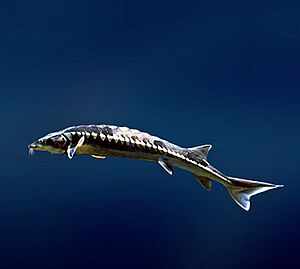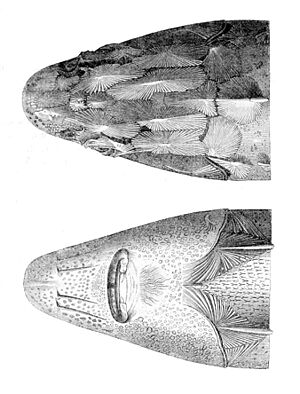Bastard sturgeon facts for kids
Quick facts for kids Ship sturgeon |
|
|---|---|
 |
|
| Conservation status | |
| Scientific classification | |
| Genus: |
Acipenser
|
| Species: |
nudiventris
|
| Synonyms | |
|
|
The ship sturgeon is a fascinating fish that lives in water. It's also called the bastard sturgeon, fringebarbel sturgeon, spiny sturgeon, or thorn sturgeon. Its scientific name is Acipenser nudiventris. These fish usually hang out near the bottom of shallow waters. You can find them close to shorelines or in estuaries. An estuary is where a river meets the sea.
Contents
What They Eat
Ship sturgeons are not picky eaters! They typically feed on other small animals. These animals live near the bottom of the water, which is called the benthos. Their diet includes insect larvae, mollusks (like snails or clams), crustaceans (like crabs), and other smaller fish.
How They Reproduce
Ship sturgeons are usually anadromous. This means they live in saltwater, like the ocean, but travel to freshwater rivers to lay their eggs. Some ship sturgeons can even spend their whole lives in freshwater. Since they travel between saltwater and freshwater, they often live near estuaries.
Spawning Season
They migrate to freshwater to lay eggs during two main times of the year. This happens in the spring, between March and May. It also occurs in the fall, from October to November.
Eggs and Young Fish
On average, a female ship sturgeon can produce a lot of eggs. She might lay between 200,000 and 300,000 eggs in her lifetime. Young ship sturgeons can stay in freshwater for several years after they hatch. However, many of them travel to the sea soon after they are born. The time between one generation of ship sturgeons and the next is about 15 years. This time can change depending on how much humans fish and if the sturgeon are doing well in their environment.
Protecting the Ship Sturgeon
The ship sturgeon used to be very common. You could find them in the Black, Aral, and Caspian seas. Now, their main home is mostly limited to the Ural River in Russia and Kazakhstan. There might also be small groups, called relict populations, in the Rioni River in Georgia and the Safid Rud in Iran.
New Homes and Challenges
One of the most well-known populations of ship sturgeons lives in Lake Balkhash in Kazakhstan. This is far from their natural home. They were brought there in the 1930s for fishing. Sadly, the number of ship sturgeons has gone down a lot. This is mainly because of too much fishing and the building of dams. Dams can block their migration paths to freshwater.
Conservation Efforts
Because of these problems, rules have been put in place to limit fishing for ship sturgeons. This is happening in areas like the Ural River. To help these fish, people have also started raising them in special facilities. After they grow, these captive-bred sturgeons are released back into the rivers they used to live in. This helps to increase their numbers in the wild.



